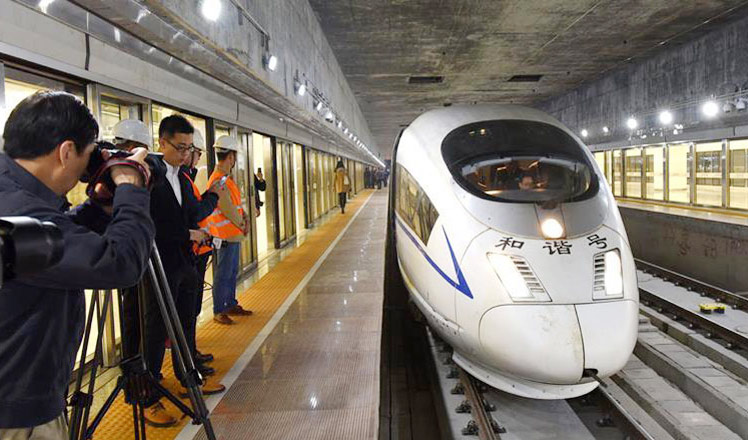Traveling into the future
Updated: 2016-01-04 07:43
By Yang Feiyue(China Daily)
|
||||||||
Insiders expect 2016 to be a shake-up year for outbound Chinese tourism. Yang Feiyue looks ahead.
China's outbound tourism was the global travel story of 2015.
It seems likely the same will hold true for this year, as trends that took root last year blossom and new seeds are planted.
The number of Chinese who travel overseas is forecast to reach 130 million - about 10 million more than last year, says Jiang Yiyi, director of the China Tourism Academy's International Tourism Development Institute, affiliated with the China National Tourism Administration. (Chinese have been the No 1 source of outbound tourists for four years.)
Countries will expand efforts to become more accessible to Chinese, especially in terms of language. International flights will increase. And Chinese will discover new destinations not currently on their radars.
Developed countries are expected to pay more attention to tourism's boon to their economies and will compete more fiercely to woo Chinese, Jiang says.
"The relaxation of visa policies toward Chinese and enhanced Chinese-language environment for visitors point toward the future," she says.
It's likely more countries will relax visa requirements for Chinese, considering surges that followed such moves last year. Chinese visits to countries swelled after they waived visas, introduced visas on arrival, streamlined application procedures or waived processing costs.
"It has proven effective," Jiang says.
South Korea, for instance, will likely remain one of the top destinations for Chinese, following incremental easing of visa requirements last year.
That contributed to the 10 percent annual increase in Chinese visits over 2014, when over 6.3 million Chinese arrived, the country's tourism authority data show.
South Korea extended Chinese tourist visas' validity from 30 to 90 days and relaxed age requirements on Dec 16. The country is expected to extend its waiving of visa fees for Chinese until the end of 2016.
South Korea has planned a special visa to be adopted this year that integrates travel with hairdressing, leisure and cultural experiences with looser income, age and education requirements for Chinese.
Holders can enjoy tax rebates at certain shops if their purchases total over 1 million won ($900) and each item is under 200,000 won.
South Korea, Japan and Southeast Asia are expected to remain the top destinations this year thanks to policies and proximity, says Yan Xin, publicity manager of China's biggest online travel agency.
Shopping is expected to give more vim to Japan.
It plans to give consumption-tax rebates for inbound tourists who spend up to 5,000 yen ($41.5) this year.
About 400,000 travelers spent 100 billion yen over last weeklong National Day holiday alone.
(About 41 percent of Chinese polled by Ctrip say they'd bring an extra suitcase for purchases.)
The Belt and Road Initiative will likely benefit Southeast Asia.
And the United States will in 2016, the US-China Tourism Year, gain from the 10-year multi-entry visa policy announced at APEC in November of 2014, Yan says.
Russia will expand its visa waiver beyond Chinese group travelers who book through accredited agencies to individual travelers this year.
Chinese visits to the neighboring nation increased 200 percent last year, Ctrip reports.
This year's increase of international flights will likely trigger explosive growth from third- and fourth-tier cities, according to a recent report by Tongcheng Network Technology, a major online travel agency in Jiangsu province's Suzhou city.
China will add at least 200 international air routes in 2016, especially those linking nations involved in the Belt and Road Initiative.
There are 663 international routes operated by domestic and foreign carriers, 369 of which started this year, Civil Aviation Administration of China head Li Jiaxiang says.
China had signed bilateral air transportation agreements with 118 countries by November, he says.
The ambitious plan is expected to benefit about 4.4 billion people in 65 nations, the government says.
Chinese will discover more off-the-beaten-track destinations this year, a recent TripAdvisor report suggests.
The report polled more than 44,000 tourists and hotel operators from 32 countries and regions worldwide.
The Seychelles and Fiji will rise on Chinese itineraries.
So will less-known places in leading destination countries, like Japan's Hokuriku and Kyushu regions, Ctrip predicts.
TV and film from last year and this year will continue to influence Chinese.
More families are expected to visit such shooting locations as Turkey and New Zealand, which in 2015 served as the backdrops for the reality show Where Are We Going, Dad?, in which celeb fathers take their kids on trips.
Ctrip forecasts Chinese will spend 22,800 yuan per-capita this year.
The yuan will likely dip slightly this year but won't curb outbound tourism, Jiang says.
It seems not much will.
Contact the writer at yangfeiyue@chinadaily.com.cn
(China Daily 01/04/2016 page22)
- Top planner targets 40% cut in PM2.5 for Beijing-Tianjin-Hebei cluster
- Yearender: Predictions for 2016 through 20 questions
- Asia's largest underground railway station opens in Shenzhen
- Shanghai bans drug-using actors, drivers
- Clamping down to clean up the air
- Yearender: Ten most talked-about newsmakers in 2015
- Over 1 million refugees have fled to Europe by sea in 2015: UN
- Turbulence injures multiple Air Canada passengers, diverts flight
- NASA releases stunning images of our planet from space station
- US-led air strikes kill IS leaders linked to Paris attacks
- DPRK senior party official Kim Yang Gon killed in car accident
- Former Israeli PM Olmert's jail term cut, cleared of main charge

 127th Tournament of Rose Parade celebrated to embrace 2016
127th Tournament of Rose Parade celebrated to embrace 2016
 Yearender: China's proposals on world's biggest issues
Yearender: China's proposals on world's biggest issues
 NASA reveals entire alphabet but F in satellite images
NASA reveals entire alphabet but F in satellite images
 Yearender: Five major sporting rivalries during 2015
Yearender: Five major sporting rivalries during 2015
 China counts down to the New Year
China counts down to the New Year
 Asia's largest underground railway station opens in Shenzhen
Asia's largest underground railway station opens in Shenzhen
 Yearender: Predictions for 2016 through 20 questions
Yearender: Predictions for 2016 through 20 questions
 World's first high-speed train line circling an island opens in Hainan
World's first high-speed train line circling an island opens in Hainan
Most Viewed
Editor's Picks

|

|

|

|

|

|
Today's Top News
Shooting rampage at US social services agency leaves 14 dead
Chinese bargain hunters are changing the retail game
Chinese president arrives in Turkey for G20 summit
Islamic State claims responsibility for Paris attacks
Obama, Netanyahu at White House seek to mend US-Israel ties
China, not Canada, is top US trade partner
Tu first Chinese to win Nobel Prize in Medicine
Huntsman says Sino-US relationship needs common goals
US Weekly

|

|








